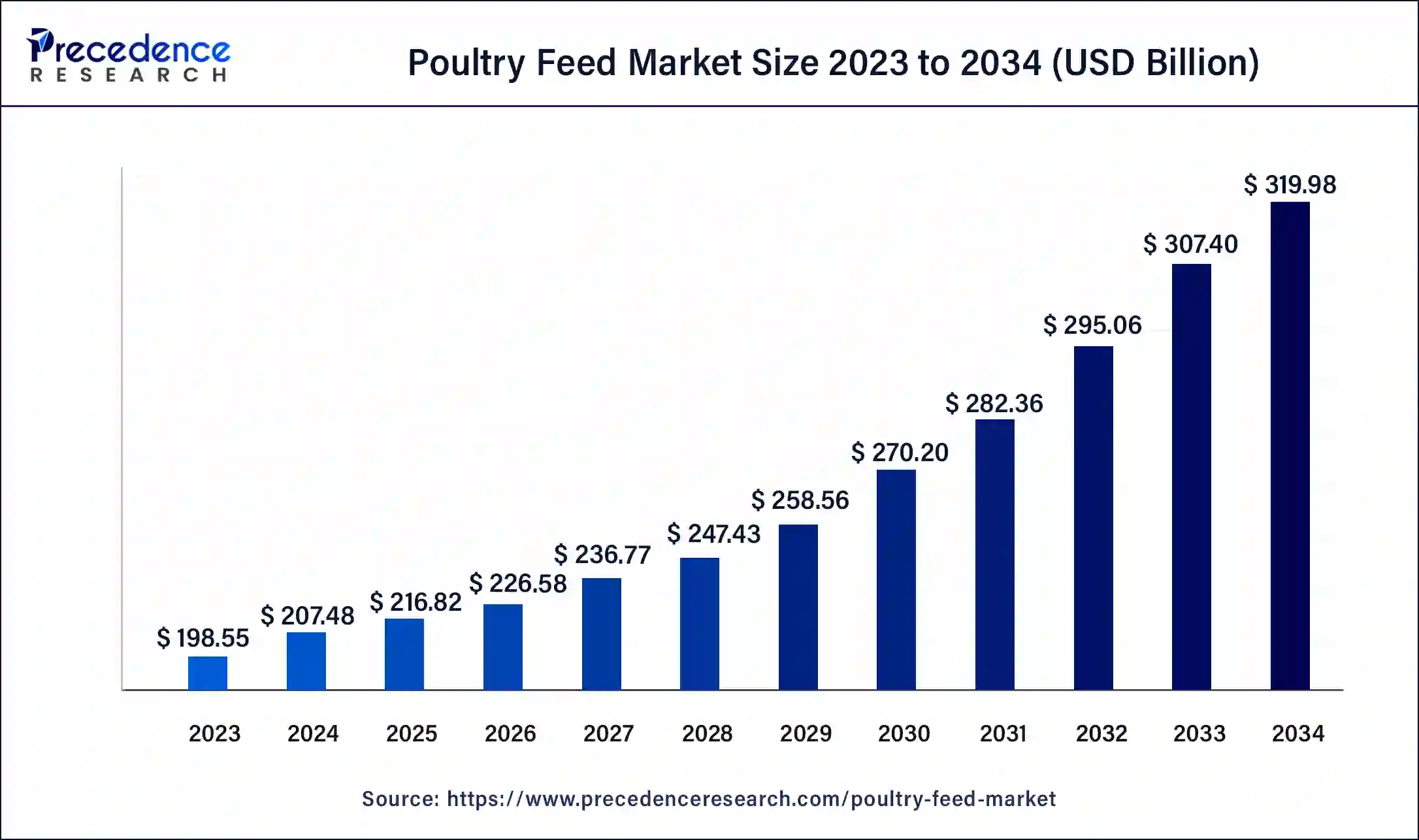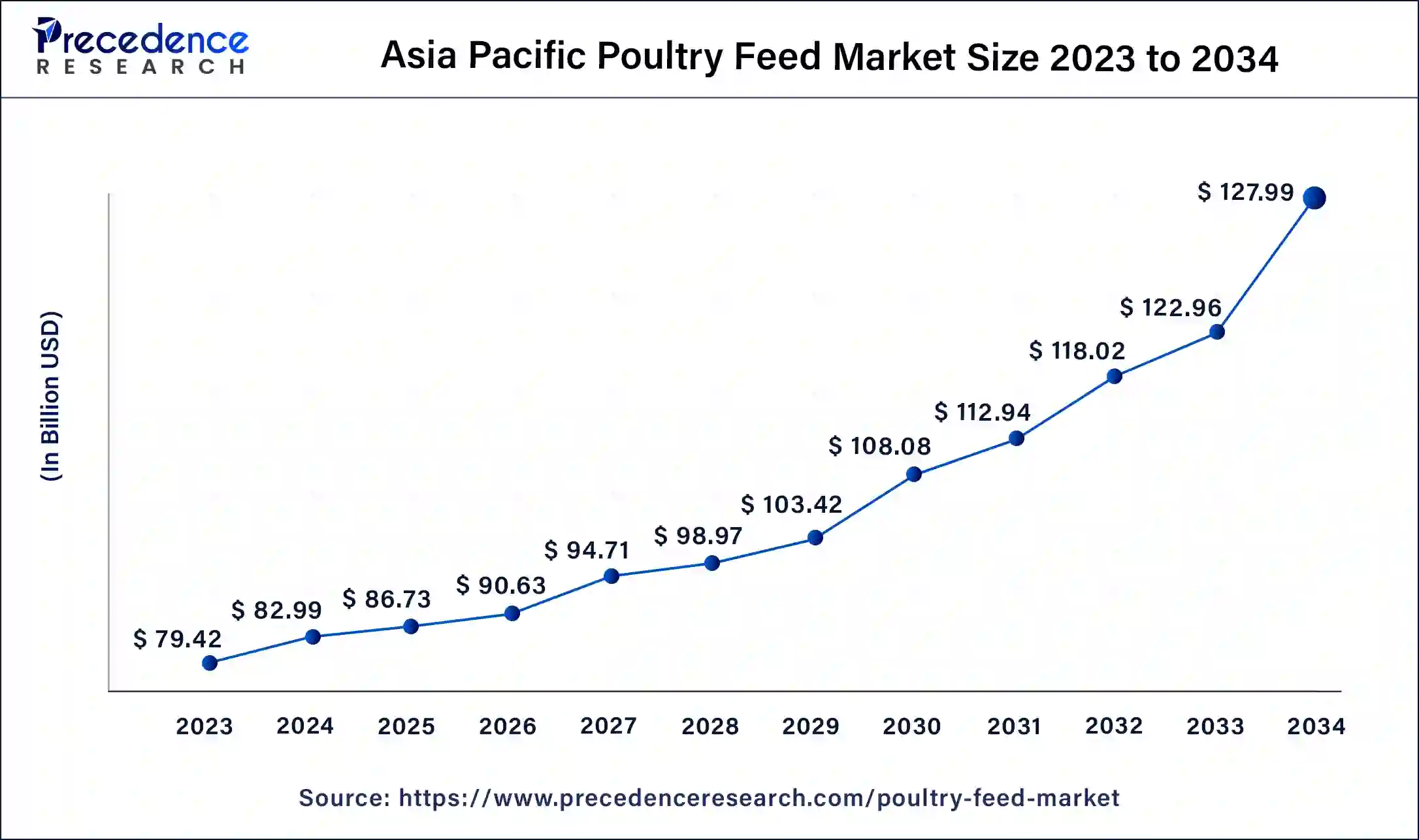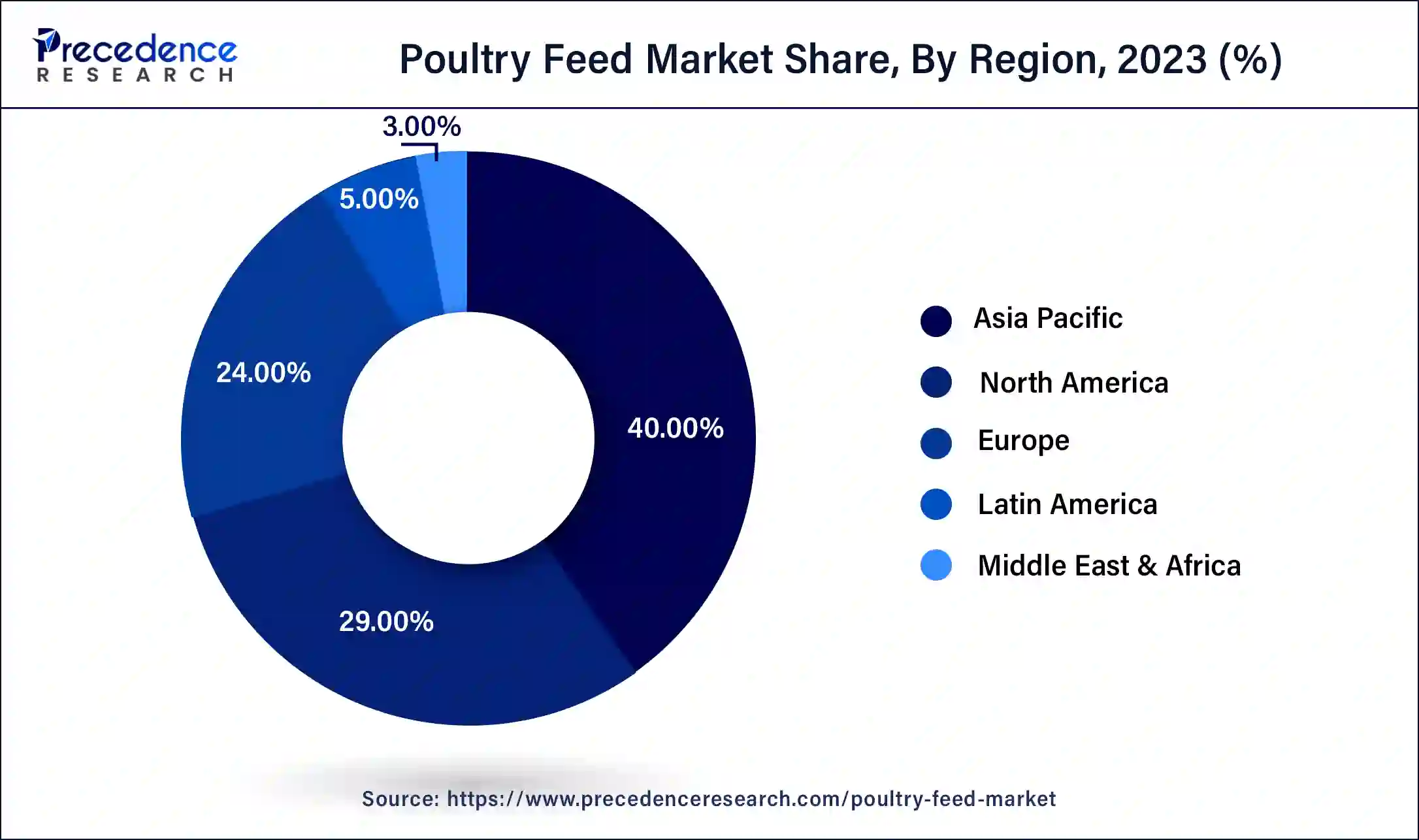January 2025
The global poultry feed market size was USD 190 billion in 2023, estimated at USD 198.55 billion in 2024 and is anticipated to reach around USD 319.98 billion by 2034, expanding at a CAGR of 4% from 2024 to 2034.
The global poultry feed market size accounted for USD 198.55 billion in 2024 and is predicted to reach around USD 319.98 billion by 2034, growing at a CAGR of 4% from 2024 to 2034.

The global poultry feed market was valued at USD 76 billion in 2023 and it is expected to be worth around USD 127.99 billion by 2034, with a CAGR of 4.43% from 2024 to 2034.

Asia-Pacific region accounted revenue share of around 40% in 2023. India and China dominate the poultry feed market in Asia-Pacific region. The growing production of feed in emerging regions is driving the growth of Asia-Pacific poultry feed market. The poultry sector accounts for roughly 70% to 75% of the Indian commercial feed business in 2019. Nearly 39 million metric tons of commercial feed were produced in the country. Poultry feed accounts for roughly 24.9 million metric tons of the country’s feed production in 2019.

North America is expected to develop at the fastest rate during the forecast period. The North American companies are engaged in meat and chicken-based ingredients processing. The North America poultry feed market is being driven by factors such as growing government initiatives, stringent government regulations, and high investments by government bodies. The poultry feed market in North America region is expected to grow due to rising broiler production in the region and customers’ preference for poultry products due to their lower prices when compared to other alternatives.
The factors such as the surge in demand for organic feed and growing production of livestock production are driving the growth of global poultry feed market. As per the Organization for Economic Co-operation and Development, poultry requires 13% fat, 60% protein, and 3% calcium. Therefore, poultry by products and fish food are used to meet the nutrient requirements. The by-product accounts for about 50% and the live market weight of ruminants and 30% of the live market weight of poultry. These by products are processed, pulverized, and used as chicken feed. Poultry meat is becoming more popular around the world, with consumption rising from 45,033 metric tons in 2018 to 45,938 metric tons in 2020.
Poultry chicken is regarded as one of the most cost-effective sources of protein and as a result, the demand for poultry goods such as eggs and meat is continually increasing. As per the United States Department of Agriculture, worldwide chicken meat production will likely to exceed 97.8 million tons in 2019, up 2% from 2018. The market for poultry feed is also growing due to favorable government regulations. By 2019, the integration of insect protein in poultry feed will have high requirement for poultry feed, thus projecting the growth of global poultry feed market. In February 2018, the European Commission’s Health and Food Safety Commissioner allowed the incorporation of insect protein in poultry feed.
The product releases, acquisitions, business expansions, joint ventures, and considerable investments in research and development are all strategies used by poultry feed makers to obtain optimal business expansion and building a positive market position. The evolving global businesses or new competitors are expected to have more chance to expand the poultry feed market, particularly in emerging nations. During the projected period, the growing government activities and growing foreign investments in the emerging agricultural sector, particularly in India and China of Asia-Pacific region, are likely to promote the growth of global poultry feed market.
Due to growing number of diseases and infections, the animals are more vulnerable to the such ailments. Thus, this factor is driving demand for poultry feed in the global market. The factors such as raw material price volatility as well as environmental concerns are expected to stymie the global poultry feed market’s expansion throughout the projection period.
| Report Coverage | Details |
| Market Size by 2034 | USD 319.98 Billion |
| Market Size in 2023 | USD 198.55 Billion |
| Market Size in 2024 | USD 207.48 Billion |
| Market Growth Rate from 2024 to 2034 | CAGR of 4% |
| Largest Market | North America |
| Base Year | 2023 |
| Forecast Period | 2024 to 2034 |
| Segments Covered | Livestock, Additives, Form, Nature, Distribution Channel, Ingredients, and Region |
| Regions Covered | North America, Europe, Asia-Pacific, Latin America, and Middle East & Africa |
The broilers segment dominated the poultry feed market in 2023 with revenue share of 71%. The broilers are chickens or birds raised purely for the purpose of producing meat. They have genes that allow them to grow more quickly than native chickens and layers. Broilers can gain a lot of weight in a short amount of time, which might cause their vents to expand or make them paralyzed and unable to walk as a result of their extreme weight increase. Broiler meals are designed to provide extra energy to help them gain weight.
The layers segment is expected to witness strong growth over the forecast period. The primary purpose of layer farming is to produce eggs. As the world’s population grows, so does the demand for food and energy, resulting in an increase in layer production around the world. The key factors driving the demand for the layers segment are rising per capita egg consumption and worldwide population increase.
The amino acid segment dominated the poultry feed market in 2023. The amino acids are the building blocks of proteins. The amino acids are left over after proteins are broken down or digested properly. The amino acid segment is growing due to benefits provided by it. It is one of the good sources of proteins and nutrition. In addition, the amino acids help in digestion of animal bodies. That’s the fact, amino acids are added to the poultry feed.
The vitamins segment is projected to grow at a strong growth during the forecast period. Vitamins are a collection of chemical molecules that must be consumed in modest amounts. Vitamins are vital additives because they govern regular bodily processes, reproduction, and growth. Water soluble vitamins and fat-soluble vitamins are two types of vitamins that can be found in the body.
Segments Covered in the Report
By Livestock
By Additives
By Form
By Nature
By Distribution Channel
By Ingredient
By Geography
For inquiries regarding discounts, bulk purchases, or customization requests, please contact us at sales@precedenceresearch.com
No cookie-cutter, only authentic analysis – take the 1st step to become a Precedence Research client
January 2025
January 2025
July 2024
August 2024